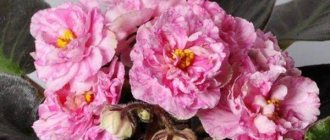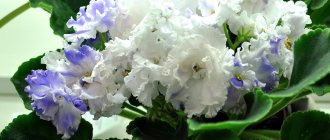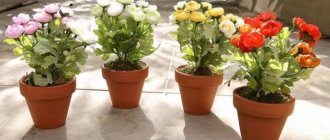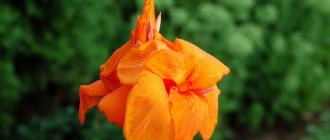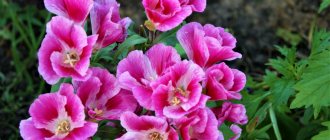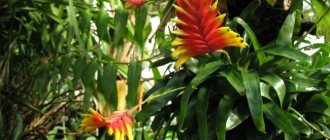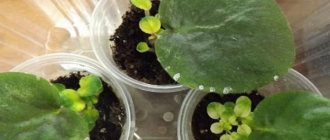Achimenes Sabrina has a large pear-shaped bulb covered with brown scales. First, flower stalks emerge from it; after flowering, linear green leaves about 40 centimeters in length appear. In our conditions it blooms from late summer to early autumn. But if the care is correct, then flowering is possible even 2 times a year.
It is recommended to leave no more than two peduncles, at the top of which there are large, bell-shaped, six-petalled flowers of attractive color. Flowers are collected together from 3 to 12 pieces in so-called “umbrellas”. After pollination, seeds of 50-80 pieces in each ripen in boxes. The plant is poisonous, so precautions should be taken when handling it.
Growing at home
Growing Achimines Sabrina (Sabrina) is possible in gardens and indoor conditions. Garden specimens are planted in June-July in containers or open ground. In September, the bulb is dug up and stored in a dry place, maintaining a temperature of 180 degrees Celsius. The problem with growing in open ground is that if there is a sudden cold snap, the plant may not have time to bloom, so it is preferable to plant it in a portable container.
Achimines Sabrina is planted at home in a container corresponding to the size of the bulb. The distance from it to the edges of the container is about 2 cm. The substrate for planting includes two parts of leaf soil with the addition of the same volume of turf, plus two parts of perlite and one part of humus.
During flowering, you need to water abundantly. After wilting, the volume and frequency of watering decreases. Peduncles are cut off at a distance of 3-4 cm from the base. When the leaves of the plant begin to fade, watering must be completed without waiting for the last leaf to fall off, because rot may appear.
During the dormant period, the dishes are transferred to a cool, dark place for 3 months; there is no need to water them. After the end of sleep, the bulbs are transferred to a bright, warm place; the abundance and regularity of watering is determined by environmental conditions. The flower is not picky about air humidity; in very dry air, the buds can be sprayed.
Table: how do care errors manifest themselves and what to do to correct the situation?
| Problem | What caused it? | How to fix the situation? |
| Gray fluffy coating on leaves, stems and buds. | Appears when overwatering or too high humidity. This often happens if you leave achimenes outside in cool and rainy weather in the summer. | Bring the plant into your apartment. Limit watering. Remove the top layer of substrate and add new soil. Treat the soil with any fungicide according to the instructions. |
| Flowering is not abundant, flowers are small. | There are not enough microelements in the soil, especially potassium. | Feed with complex fertilizer. |
| Dry brown spots on leaf blades, buds crumble. | The plant received sunburn. | Remove damaged leaves, shade the flower from direct sunlight with tulle or move it to another place with diffused light. |
| Brown edges and tips of leaves. | The indoor air is too dry. | Place sphagnum moss or pebbles in the tray and moisten periodically. Spray the air around the plant; in hot and dry weather this should be done almost daily. |
| The leaves curl. | Watering too much or the volume of the pot does not correspond to the size of the plant (container is too large). | Transfer the achimenes into a small container and reduce the amount of watering. |
Reproduction of Achimenes Sabrina
Flowers can be propagated by seed and vegetative methods. To obtain seeds, the buds are cross-pollinated with a brush. The seeds are removed from the ripened capsules and immediately sown in the prepared substrate. Its composition: leaf soil is mixed with sand (2 parts each), plus turf soil and humus (1 part each). The seeds are sprinkled on top with a layer of earth (5 mm thick). Necessary conditions: constant soil moisture and temperature 22-25 degrees Celsius. Seedlings dive into 100 ml pots after the appearance of 2 leaves. The development of young plants with this method of propagation is quite long.
A simpler method is to divide the bulb, from which the baby bulb with roots is separated during transplantation. When planting, 1/3 of its height should remain above the ground. The composition of the substrate is the same as when planting an adult plant. A young specimen will be able to bloom after 2 years. A photo of this plant is shown in the article.
Reproduction and flower care
Reproduction of the Achimenes flower can occur with the help of:
- Semyon.
- Cherenkov.
- Rhizome divisions.
- Listkov.
The first method is quite simple, because ready-made seeds can be bought in a specialized store or collected at home from an adult flower, if available. To collect homemade propagation material, you need to pollinate the inflorescences yourself. It's very simple: take a cotton swab or small brush and transfer pollen from the core of one flower to the pistil of another. Thus, artificial fertilization and the formation of seeds will occur, which can then be planted in the ground. The main thing is that this must be done at a temperature not lower than +20 degrees.
In summer, propagation of young Achimenes flowers is often carried out using apical cuttings. To do this, you need to cut off a healthy, strong stem, remove all the buds and top leaves, leaving only 1-2 pairs. After this, you can plant the treated shoot in the ground. It is advisable to cover the pot itself with a plastic bag or plastic bottle. Place the mini-greenhouse in a place with diffused lighting, and after 2-4 weeks you will see how the cuttings take root.
Propagation in spring is done by pieces of rhizomes or using rhizomes. The most effective, simplest way to propagate Achimenes, which does not require special care, is the method of dividing the rhizome. To do this, the root is cut into several pieces 4-5 cm long.
The cut sides are treated with charcoal, and then planted in fertile soil. The main nuance is that when dividing the root system, you need to take into account the presence of a sprouted shoot in each part.
Propagation of the Achimenes flower by rhizomes is not difficult in terms of cultivation and care. The main thing is to observe the temperature regime and the abundance of watering. When selecting specimens for planting, it is necessary to pay attention to their condition. It is better to throw away very dry and dark parts. And use medium-sized, light brown rhizomes as the starting material.
Reproduction using sheets is the most painstaking and time-consuming. It is rarely used, but it also has a right to exist. When choosing this method, it is necessary to select fleshy, healthy leaves and carefully cut them off. Plant in a pot with soil and peat moss, covered with a bottle or bag to create a greenhouse effect. The rooting period may take more than one week, but after this happens, the greenhouse can be removed and the plant can be grown in optimal conditions. Such a flower will be able to bloom in 1.5-2 years.
Photo of flowering
The variety is notable for its numerous small flowers of pale ruby color and a bright yellow center. The diameter of the flowers is on average about 2 centimeters.
In the photo Achimenes Sabrina:
Beneficial properties and toxicity of Achimenes
Achimenes.
Photo Achimenes pleases the eye not only with bright bell-like flowers, but also with serrated velvety leaves. Their front side is bright green, and the bottom has a reddish tint. Contemplating original flowers against a background of lush greenery brings incomparable pleasure. Lush bushes in hanging flowerpots decorate the interior. Achimenes is a non-poisonous plant that does not cause allergies or irritation. Therefore, you can safely grow it at home.
Description of Achimenes
Achimenes is a herbaceous perennial plant. No more than 30 cm in height. The stems are fleshy, branched, dark green or red. At first they grow upward, but droop with age. The rhizome is aboveground with rhizomes (tubers) covered with small scales. They accumulate useful substances that the plant will use after leaving winter dormancy.
The oblong leaves on petioles with a sharp end on the outside are smooth and shiny. They come in dark green, pink, and purple with raised veins. There are small hairs from the inner area of the plate.
At the end of spring, many flowers begin to form in the axils of the leaves along the entire length of the stem. Each corolla has a tube and 5 strongly bent, double or simple petals, separated along the edges.
Reddish, pink, yellow, snow-white, purple flowers are arranged singly or in groups of 3-6 pieces. They reach 3-6 cm in diameter. Flowering occurs until the end of September. When grown at home, it can be observed twice.
Plant diseases and pests
If there are errors in care, the plant can become sick and be affected by harmful insects. Of the diseases, root rot is the most dangerous for Achimenes. It develops with excessive watering and cold temperatures. If the damage is not severe, then you can remove the damaged areas, sprinkle the cut areas with crushed charcoal and treat with a fungicide, for example, “Fundazol”. Then it will need to be replanted into a new pot and soil.
Of the parasites, the flower is affected by aphids, spider mites, and mealybugs:
- Aphids reproduce very quickly. When it gets on a plant, it drinks the juices from it, leading to its oppression and death. The insect settles under the leaves. It is very small, so it is not always possible to see it. Treatment is carried out by wiping with a soap solution. In case of severe infection, they resort to spraying with insecticides - “Fitoverm”, “Aktellik”, etc.
- Spider mites also suck juices from the plant.. This is a small black or red insect that entwines leaves and shoots with a web. Settles on flowers growing in too dry and hot conditions. To get rid of a tick, it is necessary to maintain high air humidity, perform soap rubdowns, and spray with chemicals “Fitoverm”, “Iskra-M”, “Aktellik”.
- Mealybugs can be recognized by the characteristic white coating on the plant.. In the process of its life, it leaves white, loose discharge. They destroy it by wiping with soap solutions, treating with a solution of green soap, tobacco and garlic infusions, and the preparations “Aktara”, “Biotlin”, “Calypso”, “Confidor”, “Fitoverm”.
Achimenes, in the course of numerous breeding works, are distinguished by many species, varieties and hybrids, among which each gardener can choose his favorite color and size. Achimenes have bush and ampelous forms, which allows them to be grown both on horizontal surfaces and in a suspended form.
Common varieties
All the many varietal varieties of the plant come from long-flowered (longiflora) and large-flowered (grandiflora) achimenes.
| Name | Leaf color | Flower shape and color |
| Cote d'Ivoire | Rich green | They can be double or semi-double with a light yellow base color with a bright yellow center from which brownish rays emerge. As you can see in the photo, there are spots of light lilac color along its jagged petals |
| Peach blossom | Bright green | The form is simple. The color is purplish-red with gold flecks throughout the flower. |
| Ice tea | Bright green | The petals are simple with a wavy edge of pinkish-peach color. Along the bright yellow throat there are dots and streaks of burgundy color (see photo) |
| Yellow english rose | Dark green | The edges of the petals are decorated with fringe, which gives the flowers a resemblance to roses. Color varies from light yellow to peach |
| Sauline | Bright green | They can be double or semi-double with a light yellow base color with a bright yellow center from which brownish rays emerge. As you can see in the photo, there are spots of light lilac color along its jagged petals |
| Serge saliba | Rich green | The shape can be terry or semi-double. The color is bright red with pink-orange tints. The bright yellow center is covered with red spots and streaks |
| Dot | Dark green | The light pink or lilac petals of the simple flowers are covered with a blue-violet net. Throat bright yellow |
| Strawberry lemon | Light green | The form is simple. The color of the petals is yellow, with raspberry-colored spots distributed unevenly along them, which over time acquire a peach tint. Brownish rays come out of the throat |
| Rainbow warrior | Dark green | The petals of simple flowers have a wavy edge and a blue-violet color. The yellow throat is decorated with rays of dark purple color |
| Nero | Bright green | The form can be either semi-double or simple. The color of the petals is bright red. The throat is yellow and covered with brownish rays |
| Sabrina | Light green | Flowers of simple shape have bright pink petals and a yellow throat. |
| Abendrot | Light green | Terry shape, yellowish-peach color |
| Ambroise verschaffelt | Rich green | Flowers of simple shape have bluish petals. The throat is yellow, violet rays come out of it |
| Honey queen | Dark green | The light yellow petals of simple flowers are decorated with a bright purple border, along which yellow spots are scattered. Throat bright yellow |
| Double pink rose | Light green | Double-shaped flowers have a soft pink color |
| Last dawn | Light green | Small specks are scattered on the petals of double flowers of lilac-raspberry color |
| Blueberry lemon | Light green | Double and single yellow flowers with a lilac pattern can bloom on one bush |
| Peach orchard | Bright green | Double-shaped flowers have a bright peach color |
| Nightfall | Light green | Terry flowers of bright cherry color |
| Glory | Dark green | The shape of the flowers is simple, the color of the petals is bright red, the throat is yellow |
| Alter ego | Bright green | The color of double flowers can be light blue or blue-violet |
| Purple king | Light green | Simple flowers have a bright lilac color, petals with fringe and a mesh pattern |
| Petite fadette | Dark green | Double bright red flowers with a dark red center |
| Yellow fever | Bright green | Flowers of double or semi-double form have a bright yellow center and pinkish petals at the edges |
| Lemon orchard | Light green | Light green Terry flowers of soft yellow color are decorated with a pink border and red strokes |
| Hard to get | Bright green | Flowers can be double or semi-double. The color of the petals is fuchsia-raspberry, the throat is yellow, with cherry spots around it. |
| Sun wind | Dark green | Flowers of simple shape can be white or light pink, which becomes more intense at the edges. Throat yellow with speckles of orange or reddish-brown color |
| Caprice | Dark green | Wavy petals of simple flowers of lilac color, the center is formed by rays and spots of yellow and brown color |
| Peach glow | Dark green | Flowers of a simple shape have jagged edges and a delicate peach color, the throat is yellow |
| Hugues aufray | Dark green | Simple flowers with bright yellow petals, decorated with a lilac-lilac border. |
| Red elfe | Dark green | Bright red simple flowers, the center consists of brown dots and streaks |
| Golden lady | Dark green | The simple-shaped flowers have light yellow petals with lilac-pink edges and the same pattern. There may be another yellow petal in the throat |
| Lady in black | Dark green | Simple flowers of a very dark wine color with rays in the center of dark brown and yellow color |
| Orange delight | Light green | The flowers have a simple shape and a bright reddish-orange color. The petals are wavy, the throat is golden with rays of brown and lilac. |
| Snow princess | Bright green | Simple flowers of white color with spots of yellow and purple color in the center |
The rustic beauty of half-forgotten Achimenes
Relatives of the beloved Saintpaulia Achimenes have almost disappeared from the shelves of flower centers in the last decade. They are often classified as “grandmother’s” plants, underestimating the beauty of both greenery and flowering. It is for the latter that Achimenes are grown. At the peak of flowering, they resemble chintz fabrics, thanks to the bright single flowers dotting the cushions of greenery.
The status of a beautifully flowering plant does not make Achimenes capricious: it is a hardy, undemanding, but somewhat unusual plant for lovers of romantic classics.
Achimenes, unlike the closest relatives of Saintpaulia, do not belong to African endemics. This plant came to us from the South American flora, having lost in the process of domestication both the ability to develop quite aggressively and to have a larger size. True, Achimenes does not belong to the capricious tropical plants, living mainly in the subtropics and being content with average air humidity.
The name Achimenes supposedly received back in the days of Ancient Hellas, with the light hand of Pliny, who gave the name of the “magic plant” (according to another version - “afraid of the cold”), but debate about the origin of the name is still ongoing. Despite its rather bright appearance, popular nicknames for Achimenes are not so popular, although many people like to call this plant “a friendly family.”
Achimenes are mistaken for traditional rhizomatous herbaceous perennials. They have a very unusual rhizome, developing in the form of scaly-cone-shaped, elongated rhizomes, somewhat similar to caterpillars, and thanks to them they differ from any other representative of the Gesneriev family.
Surface roots require the correct selection of containers for growing. Tuberous rhizomes are light, up to 7 cm in length. The height of the Achimenes bushes will not exceed 20-30 cm. Conventionally, these plants are divided into two varieties - ampelous forms with drooping shoots and upright or bushy Achimenes, which are sometimes presented in catalogs as erect Achimenes.
They differ only in the form of growth and the flexibility of the shoots. Drooping, thin shoots, unable to withstand the weight of leaves and inflorescences in the former, and slightly stronger, but not rigid, upright growing shoots in the latter. Achimenes are easily formed, allowing, thanks to light pruning, to control the size and shape of the bushes, but by nature they are quite thick and lush, stretching only in extremely unsuitable conditions. The shoots of Achimenes can reach 60 cm in length.
The foliage of Achimenes is simple, with its wrinkled, generously veined surface and general shape similar to nettles. The softness of the leaves, pleasant to the touch, is combined with intense dark, most often cold emerald, shades of color. A reddish tint appears on the underside of the leaves.
Some varieties have leaves that are purple in color; almost all Achimenes have a beautiful, pleasant edge on the leaves and shoots, surprising with long hairs. Pointed tips, coarsely toothed edges, opposite arrangement, smaller internodes at the tips of the shoots allow Achimenes to create the effect of a cushion of greenery. The thinness of the leaf blade and the glossy shine of the surface often seem unusual.
Achimenes blooms profusely from July to September, although many hybrids can bloom for more than three months. © miculparadis
How and when does Achimenes bloom?
Achimenes flowers really look rustic, but once you take a closer look at them, the original asymmetry, unusual structure, and beautiful details will become noticeable. The narrow tube turns into a flat limb with five tightly overlapping round lobes-petals, in which the smaller size of the two upper petals is not always noticeable and manifests itself differently in varieties.
The diameter of the corolla can reach 5 cm. The throat is always contrasting, most often yellow, with original spots and strokes that are almost invisible from a distance, but decorate the plant. Achimenes are characterized for the most part by single, sessile flowers in the axils of the leaves, although some new hybrids have flowers collected in loose racemes.
The color range of Achimenes includes the purest shades of pink colors - watercolor, easily recognizable, bright colors associated with the blooming classics. Candy pink and raspberry, salmon and scarlet, lilac and violet in different varieties amaze with their purity. Today, two-color varieties of Achimenes are also very popular, although the plant is associated primarily with flowers of pure and bright acrylic colors.
The flowering period of Achimenes traditionally occurs during the hottest summer months. Most varieties bloom from July to September, although many hybrids can bloom profusely for more than three months. Each flower lasts only a few days, but the rate of release of new buds completely compensates for the speed of rapid flowering.
Features of Achimenes
Translated from Greek, the name of the flower means “those who are afraid of the cold.” In the coldest months of the year, the plant actually feels uncomfortable even in a warm apartment, and therefore goes into a short “hibernation”, but it pleases its owner with flowers for quite a long time - from May to October.
The variety of colors is as rich as in the natural habitat.
In addition, breeders have made their contribution - many varieties of Achimenes have been created with unusual colors, which are never found in nature.
Achimenes come in upright and ampelous (the latter are most actively used in indoor floriculture), terry and simple.
As for shades, there are a lot of options - plain and with various inclusions. The flower calyx is 2-5 cm in diameter, and the length of the stems ranges from 20 to 60 cm depending on the variety.
The flowers are very delicate and their lifespan is short. However, the plant does not lose its decorative value, because the wilted ones are immediately replaced by new buds. They are located along the entire length of the stem in the leaf axils, forming a bright garland.
A distinctive feature of Achimenes is the nodules located on the roots, very similar to birch catkins or miniature spruce cones. These are rhizomes, excellent planting material, so originally invented by nature itself.
Plant differences
Achimenes differ in the following characteristics:
- Type of shoots - there are types in which they grow upward (erect), and there are those in which they droop (ampeloid).
- Bush height - various species, varieties and hybrids form bushes with a height of 30 to 50 cm.
- The size of the buds is small, medium and large, reaching a diameter of 2.5 to 6 cm.
- The color scheme of the buds - the petals can be pink, purple, white, red, yellow, orange.
- Level of doubleness of flowers - petals are smooth, semi-double and double.
- Flower shape - during flowering, round, long, bell-shaped buds are formed.
In the photo is the variety Achimenes Etienne Anderson:
Care
Tropical achimenes is able to bloom in almost any conditions. It needs light and comfortable humidity, and everything else is minor details!
Temperature
The best temperature for heat-loving achimenes is 20-25 degrees, and in winter for tubers - 13-15 degrees. In summer, the flowerpot can be taken outside, onto the veranda or onto an open balcony.
Soil and pot
The soil for planting Achimenes should be loose and light. To make your own soil, you can take leaf soil (3 parts), peat (1 part), sphagnum moss (1 part), coarse sand (1 part). The following substrate is also suitable for achimenes: leaf soil (2 parts), turf soil (3 parts), humus (1 part), coarse sand (1 part). Sand can be replaced with perlite (vermiculite), then the substrate will retain moisture longer.
You can add a little charcoal, mullein and shell rock to the prepared soil mixtures. Ready-made soil is used for planting ornamental flowering plants. The drainage layer should fill one third of the pot.
Achimenes has short roots, so it requires a wide, low container, since in a high pot the soil may begin to sour, which leads to rotting of the root system. For those plants that are grown as hanging plants, use hanging flowerpots.
Lighting
Choose a sunny place, but in the heat of the day it is better to avoid direct rays. Too harsh midday sun can burn delicate leaves and petals.
Watering
Achimenes prefers moist soil, so it is watered as the top layer dries. But in winter, during the dormant period, we advise you to avoid watering as much as possible. Leaves cannot be sprayed, but you can place trays with wet sand or moss.
Feeding
For young, actively developing and flowering achimenes, timely feeding is extremely necessary. Most often, they are carried out once every 7-10 days, using special complex fertilizers for indoor flowers. Fertilizing with Fertika Lux gives very good results.
During the formation of buds, it is recommended to feed plants with fertilizers containing phosphorus and potassium. Fertilizing with a high nitrogen content should be applied with caution, since an excess of this element in the soil mixture can provoke vigorous development of green mass and weak budding.
For very young Achimenes growing root mass, phosphorus-based fertilizers are recommended. This element plays an important role in the proper formation of roots. Typically, at this stage, flower growers use the “Rikat Start” product.
Replanting and pruning
Achimenes is transplanted every year in early spring after it emerges from the dormant period. The tubers are planted in small boxes and transferred to a room with a temperature of about twenty degrees. After the emerging shoots have grown sufficiently, the young plants are transplanted into separate pots.
Procedures during the plant's dormant period
The dormant period for exotic plants begins in mid-October and lasts until early spring. During this time interval it is necessary to limit watering. Having been saturated with life-giving moisture, the roots of the plant prepare for “hibernation.” The above-ground part of the bush dries out halfway.
The owner’s task is to cut off the withered stems and place the container with the roots in a cooler place protected from sunlight.
At the beginning of spring, having noticed the first manifestations of the plant’s “wakefulness”, you need to place the pot in a lighted place. Extending daylight hours will contribute to faster and more complete development of the green pet.
Bloom
The buds begin to form in late spring and bloom in June. Flowering is characterized by an undulating flow: some flowers gradually fade, while others bloom. This continues until September-October, when due to lack of light and heat the plant enters the dormant phase.
Important! Such time intervals are typical for Achimenes, whose rhizomes are planted in late February - early March. If the planting dates are shifted, then flowering will begin later.
